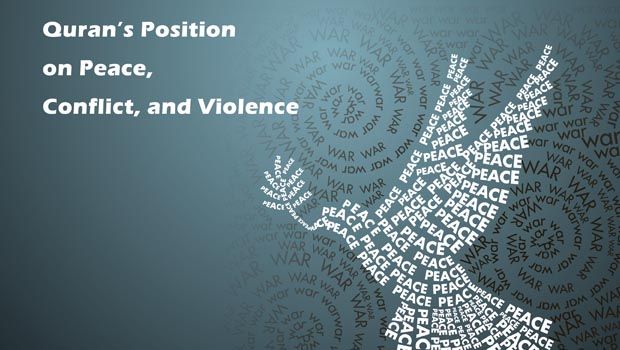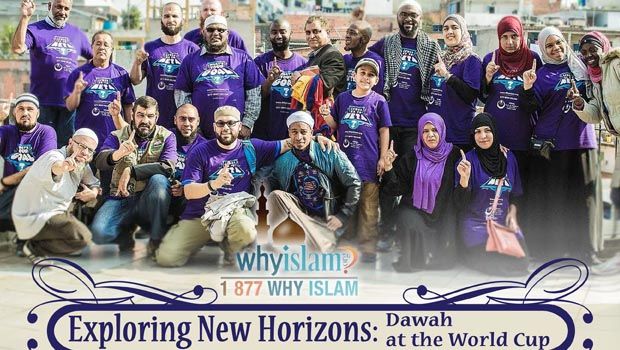In recent times some acts of violence have been committed in the name of Islam. Many Muslims have condemned such acts as being contrary to the spirit of their religion. Some non-Muslims as well have supported Muslims in clarifying that Islam is a religion of peace, and that extremists have no right to appeal to the religion to justify their acts of terrorism and violence. A few voices, however, insist that this is really about the religion of Islam; they say that violence is rooted in the life example of Islam’s prophet, and in its sacred scripture, the Quran. If what they say is true, then it must be admitted. If what they say is false, then we ought to urgently voice the necessary correction. Hence we take a closer look here at the Quran and the Prophet to see whether these stand for peace or violence.
Although non-Muslim scholars do not accept the Quran as the Word of God, they agree with Muslims that it represents the most authentic source for the life and teachings of Prophet Muhammad, on whom be peace. The Quran, as with any book, has to be read inter-textually and contextually. An inter-textual reading is an attempt to understand one Quranic verse in the light of its other verses. Classical Muslim scholars referred to this principle by saying that parts of the Quran explain other parts. A contextual reading is an attempt to understand the Quran in the light of its socio-political historical circumstances. Classical Muslim scholars refer to this principle as the circumstances of revelation.
The Circumstances of Quran’s Revelation
The Quran does not describe its own circumstances of revelation in any detail. Hence to establish context we must turn to other sources — the seerah (biography of Prophet Muhammad) and hadeeth (sayings and traditions of the Prophet). The hadeeth were compiled later, and are known to be comprised of authentic as well as inauthentic materials. For our exercise here, however, we may limit ourselves to the materials which non-Muslim scholars generally deem to be authentic. William Montgomery Watt is a recognised scholar who has written much on Islam and its Prophet. In his book, Early Islam: Collected Articles, he argues that regarding the basic outline of major events, the seerah can be accepted as authentic. Here we will depend on that basic outline in understanding the Quran’s attitude to peace and violence.
It is well known that the Quran was not written all at once, but was proclaimed orally, a portion at a time, by the Prophet over a period of 23 years. The verses comment on events as they arise, offering guidance on the full variety of human concerns, including questions of peace and war. To understand what each revealed portion means, we need to read the Quran, as suggested, inter-textually and contextually. As for context, we need to follow the broad outline of events in the life of the Prophet and chart the verses about peace and war within that chronology.
Patience During the Early Period of Islam
The Prophet began his preaching in Makkah following his first experience of revelation in the year 610 CE. For the next decade, he and his few followers were persecuted by fellow tribesmen who were antagonistic to the Prophet’s message. Many passages of the Quran, referred to as the Makkan chapters, were revealed during this period. Some Makkan passages refer to the fact that Muslims were being persecuted, and in some instances even tortured, in an attempt to force their conversion back to paganism. Such passages exhort the Muslims to be patient in the face of such persecution and to remain firm in their faith regardless of what they had to endure.
Seeking a safe haven to practice their faith, Muslims began migrating to Abyssinia which was then ruled by a Christian king known for his tolerance. Eventually the Prophet himself migrated to Madinah, about 250 miles north of Makkah, and his followers gravitated to that town. What followed was a series of battles with the pagans of Makkah who remained committed to undermining the Prophet’s mission. In the second year after the migration (hence 2 H), he engaged the pagans at Badr; in 3 H at Uhud; and in 5 H at the trench (khandaq) on the northern approach to Madinah. The last of these locations was clearly connected to Madinah, the city of the Prophet. He and his followers had dug a trench to stall the advance of the invading pagan army. The other two locations are also interesting, as they give some indication of who was launching the offensive. Uhud is located just outside Madinah. To this day, when Muslim pilgrims visit Madinah, they often take a short taxi ride to that site to pray for the souls of the Muslims who died in that battle. Badr is also accessible from Madinah, though further away than Uhud. It is already becoming evident, that the Prophet at his new city was being attacked by the Makkans who would travel more than two hundred miles to engage him in battle.
Defending Themselves Against Aggressors
It was in this period that the Muslims had to defend themselves, for now a Muslim state had been established, and it is the responsibility of every state to protect its citizens from such attacks. Verses in Madinah chapters that direct Muslims to fight the enemy must be understood in this context; they refer not to just any enemy, but to those pagans at the time who were bent on wiping out the religion and its followers. Even so, the verses (for example 2:190) make it plain that Muslims are only to engage those who were attacking them, and in no case are they to be the aggressors, for God does not like those who engage in aggression. The justification for engaging the enemy was so that the persecution already experienced in the Makkan phase would not be repeated (2:191, 2:217). Moreover, according to the Quran, it was about time that the Muslims defended themselves. They were driven away from their Makkan homes and still the antagonists were intent on killing them. Quranic verses point out that if some people do not rise in defense, invaders might demolish synagogues, churches, monasteries, and mosques (22:39-40). Finally, it was necessary to come to the aid of those elements in society who were most vulnerable such as the elderly, and women and children (4:75). Even this passage is hedged with cautions and limitations of justifiable engagement. The Quran says: “But if they hold aloof from you and wage not war against you and offer you peace, God allows you no way against them” (4:90).
In 6 H the Prophet and his Companions set out to make a pilgrimage to the sacred mosque, the Kaaba, in Makkah, the Prophet’s hometown. They were stopped short at Hudaybiya near Makkah and prevented from entering the city. According to the recognised rules of the day, they should have had the freedom to perform their devotions. The Muslims wanted to fight their way through as they were wont to do in the old days. But the Prophet instead entered into peace negotiations with the enemy. The treaty drawn up had stipulations that were unfair to the Muslims and favourable to the pagans. This too was difficult for the Muslims to accept. But the Prophet agreed to this, for it included the one condition that was an advantage to everyone: there would be no fighting for ten years. The Quran referred to this as a clear victory for Islam (48:1). The agreement stayed in effect only for eighteen months before the pagans violated it. The Muslims eventually came to understand in what way it was a clear victory. It is noted in the Quranic commentaries that in the eighteen months while the treaty was in effect more people embraced Islam as their new faith than the number of people who did so in the eighteen years prior to that.
Moreover, many who did not embrace Islam at least developed some appreciation for it. During times of war the people were in their fight-or-flight mode of thinking, and hence they paid little attention to the intellectual call of Islam. But in peacetime they interacted with Muslims and learned about the new faith in friendly dialogue. Soon the public sympathy for Islam had reached a threshold which made it possible for it to ultimately become the religion of Makkah. In 8 H, following the cancellation of the treaty, the Prophet was able to gather enough followers to march into Makkah as an unstoppable and somewhat welcome force and to take it over while declaring a general amnesty to his previous persecutors.
Pockets of Resistance and Hostility Remained
The Muslims were now generally safe to practice their religion in Makkah and Madinah, for it was now the official religion in both areas. But there were pockets of resistance, people who would ambush and kill defenseless Muslims. In 9 H the Quran’s 9th chapter declared that the Muslims would have no further ceasefire obligations to such guerrillas (9:1). They were given a grace period of four months (9:2). Within that period they were to either cease their hostilities or clear the area (9:3). The declared warning did not affect those who were willing to abide by their treaty with the Muslims (9:4). At the end of the stipulated period, the Muslims were told to respond in kind to their attempts to ambush and kill Muslims. But even then, if the aggressors repented and established prayer and gave charity, they were to be spared (9:5). And even in this situation of open war, if a non-Muslim were to come to the Muslim area seeking refuge, he was to be given refuge so that he might hear the Word of God. Afterwards, such a non-Muslim was to be transported back to a place where he would be safe (9:6). Hence, it is clear that even here the declaration of war at a most critical time is hedged with cautions and limitations, and a safety net is provided for those who were not hostile to Muslims. In fact, 9:6 makes Muslims responsible for the safety of such individuals. Looking at these verses intertextually and contextually, it is clear that those who extract and use 9:5 above without its surrounding verses, and without paying attention to the social situation, violate the text.
We may add that these measures, harsh though they were, were necessary at the time to enforce peace and ensure the safety of the general populace. This made it possible near the end of 10 H for the Prophet to perform the Hajj to Makkah and for his followers to join him there from all directions, such that they numbered 120,000. His mission now complete, the Prophet returned home to Madinah where he died peacefully a few months later in 11 H.
The Quran Promotes Peace, Not Violence
Having placed the Quranic verses within the basic outline of the Prophet’s life as gleaned from the seerah works, and having connected the dots between verses of the Quran, we are able to reach a firm conclusion. Our contextual and intertextual reading of the Quran shows that the Quran is about peace, not violence. When the Muslims had no state they were told to stay firm in their faith and to bear persecution with patience. When they had a state they were told to rise as a state in the defense of their right to live in peace and security, in defense of their weak citizens and of the places of worship which the pagans were targeting for demolition. The major battles were fought from the defensive proximity of the Prophet’s city. Each time the pagans came back with a larger force than previously, forcing the Muslims eventually to defend their city by digging a trench to hold off the invaders. When the Prophet had the opportunity to sign a treaty he did so. The Quran called this a victory, because Islam is about peace. When the Muslims grew in number and could re-enter Makkah as victors, they did so while forgiving their persecutors.
Verses which permitted Muslims to fight did so with cautions and limitations. A verse which is nowadays often quoted by itself for shock effect because it declares war does not occur by itself. It has a position within the text and a historical context. Taking it by itself, its meaning is distorted. But it is this kind of distortion that the extremists thrive on. They attempt to justify their killing of civilians with a verse which is about fighting those who were ambushing and killing Muslims. The extremists today who behead workers and journalists ignore 9:6 which instruct Muslims to transport such persons to their places of safety. Those who kill civilians in the name of Islam ignore 2:190 which allows for a war of self-defense but prohibits aggression by Muslims — any unprovoked attacks or violations of rights — even within the context of warfare. Those voices are grossly incorrect which, in recent times, spread the idea that the terrorists are following the Quran and the life example of the Prophet. In fact they distort the Quran and misunderstand the Prophet’s life example. The Quran’s instruction to Muslims is this: “O you who believe! Enter into peace altogether” (2:208).





